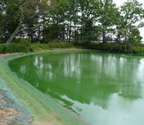It sounds like something out of a late-night horror movie — thick green muck spreading across a lake and disrupting the drinking water supply for 400,000+ people. But it wasn’t Hollywood — it was Lake Erie and Toledo, OH in summer 2014.
 That harmful algal bloom (HAB) and others are discussed in the ET&C Focus article “Are harmful algal blooms becoming the greatest inland water quality threat to public health and aquatic ecosystems?” published in the January 2016 issue of Environmental Toxicology and Chemistry. The article is co-authored by Wisconsin State Laboratory of Hygiene Environmental Toxicologist Dawn Perkins.
That harmful algal bloom (HAB) and others are discussed in the ET&C Focus article “Are harmful algal blooms becoming the greatest inland water quality threat to public health and aquatic ecosystems?” published in the January 2016 issue of Environmental Toxicology and Chemistry. The article is co-authored by Wisconsin State Laboratory of Hygiene Environmental Toxicologist Dawn Perkins.
While the authors don’t have an exact answer to their question yet, they do outline the challenges ahead and the information that is still needed to ensure the story has a happy Hollywood ending.
From the article –
HABS … in Focus
- Harmful algal blooms (HABs) represent a transformational threat to inland water quality.
- Formal monitoring and surveillance programs for HABs are limited in developed and developing nations.
- Site-specific HAB events degrade water quality to a greater extent than many chemicals.
- Harmful algal blooms confound routine surface water quality assessment and management practices.
- Strategic engagement by environmental toxicology, chemistry, and risk assessment is necessary.
“Are harmful algal blooms becoming the greatest inland water quality threat to public health and aquatic ecosystems?” Environmental Toxicology and Chemistry, vol. 35. no. 1, January 2016
